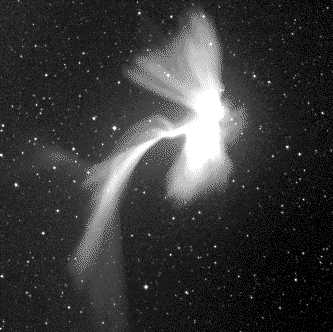Credit & Copyright: ROTSE Team
Explanation:
Click on the above image and watch a
Leonid meteor explode.
The tremendous heat generated by the collision of a
small sand-bit moving at 70 kilometers/second with the
Earth's upper atmosphere causes the rock-fragment to
heat up, glow brightly, and disintegrate.
In some cases, the
meteor literally explodes leaving a
visible cloud that dissipates slowly.
The above image shows just such an explosion for a bright
meteor from the recent
Leonid Meteor Shower.
Clicking on the
above image will start a
(4.2 Megabtye) movie of thirty
1-minute exposures showing the explosion cloud dissipate.
Each movie frame, taken with the
ROTSE
telescope early 17 November, is 8 degrees across -
16 times the diameter of the full moon.
Near the middle of the sequence, a less bright
meteor moves through the field.
1999 2000 2001 2002 2003 2004 2005 2006 2007 2008 2009 2010 2011 2012 2013 2014 2015 2016 2017 2018 2019 2020 2021 2022 2023 2024 2025 |
Yanvar' Fevral' Mart Aprel' Mai Iyun' Iyul' Avgust Sentyabr' Oktyabr' Noyabr' Dekabr' |
NASA Web Site Statements, Warnings, and Disclaimers
NASA Official: Jay Norris. Specific rights apply.
A service of: LHEA at NASA / GSFC
& Michigan Tech. U.
|
Publikacii s klyuchevymi slovami:
Leonids - meteor - Leonidy - Meteor - meteornyi dozhd' - Meteornyi potok
Publikacii so slovami: Leonids - meteor - Leonidy - Meteor - meteornyi dozhd' - Meteornyi potok | |
Sm. takzhe:
Vse publikacii na tu zhe temu >> | |
